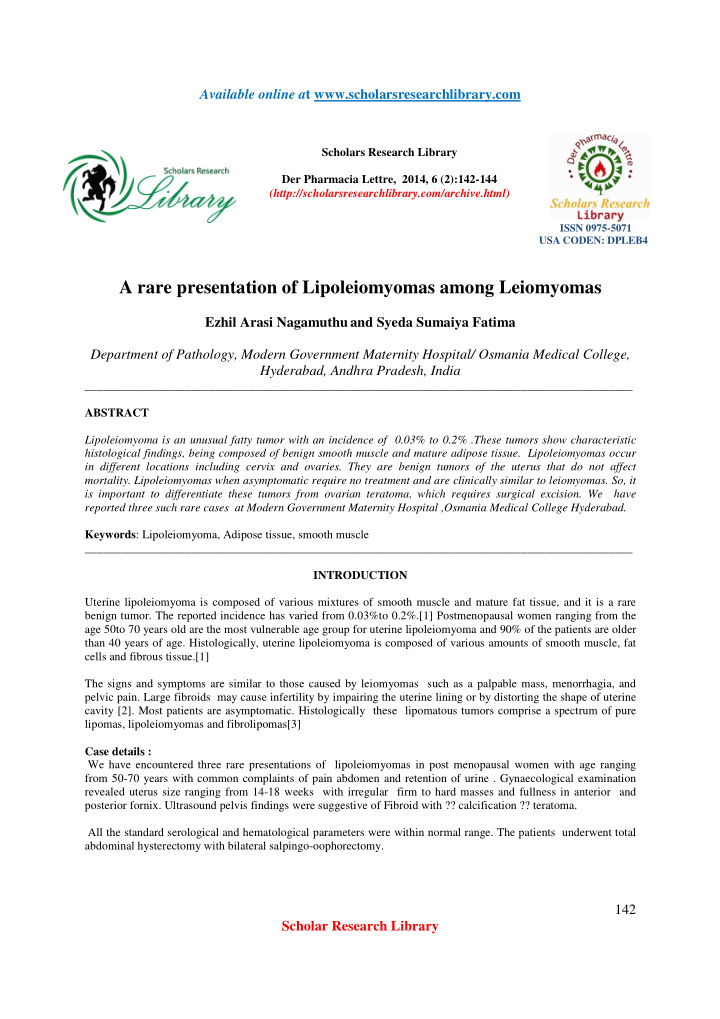



Available online a t www.scholarsresearchlibrary.com Scholars Research Library Der Pharmacia Lettre, 2014, 6 (2):142-144 (http://scholarsresearchlibrary.com/archive.html) ISSN 0975-5071 USA CODEN: DPLEB4 A rare presentation of Lipoleiomyomas among Leiomyomas Ezhil Arasi Nagamuthu and Syeda Sumaiya Fatima Department of Pathology, Modern Government Maternity Hospital/ Osmania Medical College, Hyderabad, Andhra Pradesh, India _____________________________________________________________________________________________ ABSTRACT Lipoleiomyoma is an unusual fatty tumor with an incidence of 0.03% to 0.2% .These tumors show characteristic histological findings, being composed of benign smooth muscle and mature adipose tissue. Lipoleiomyomas occur in different locations including cervix and ovaries. They are benign tumors of the uterus that do not affect mortality. Lipoleiomyomas when asymptomatic require no treatment and are clinically similar to leiomyomas. So, it is important to differentiate these tumors from ovarian teratoma, which requires surgical excision. We have reported three such rare cases at Modern Government Maternity Hospital ,Osmania Medical College Hyderabad. Keywords : Lipoleiomyoma, Adipose tissue, smooth muscle _____________________________________________________________________________________________ INTRODUCTION Uterine lipoleiomyoma is composed of various mixtures of smooth muscle and mature fat tissue, and it is a rare benign tumor. The reported incidence has varied from 0.03%to 0.2%.[1] Postmenopausal women ranging from the age 50to 70 years old are the most vulnerable age group for uterine lipoleiomyoma and 90% of the patients are older than 40 years of age. Histologically, uterine lipoleiomyoma is composed of various amounts of smooth muscle, fat cells and fibrous tissue.[1] The signs and symptoms are similar to those caused by leiomyomas such as a palpable mass, menorrhagia, and pelvic pain. Large fibroids may cause infertility by impairing the uterine lining or by distorting the shape of uterine cavity [2]. Most patients are asymptomatic. Histologically these lipomatous tumors comprise a spectrum of pure lipomas, lipoleiomyomas and fibrolipomas[3] Case details : We have encountered three rare presentations of lipoleiomyomas in post menopausal women with age ranging from 50-70 years with common complaints of pain abdomen and retention of urine . Gynaecological examination revealed uterus size ranging from 14-18 weeks with irregular firm to hard masses and fullness in anterior and posterior fornix. Ultrasound pelvis findings were suggestive of Fibroid with ?? calcification ?? teratoma. All the standard serological and hematological parameters were within normal range. The patients underwent total abdominal hysterectomy with bilateral salpingo-oophorectomy. 142 Scholar Research Library
Ezhil Arasi Nagamuthu and Syeda da Sumaiya Fatima Der Pharmacia L a Lettre, 2014, 6 (2):142-144 _________________________ _______________________________________ ____________________ On gross examination of the specime imen uterus measured ranging from 10-12 cm size soft to t to firm in consistency with the cut section showing capsulated grey white to yellow areas ,[Figure 1] Figu igure 1 : Gross with cut section showing grey yellow areas. Materials and Methods : The gros oss specimens were fixed in 10%formalin for process essing. After gross analysis representative sections were give iven for tissue processing .Sections were processed routinely with paraffin embedding and stained with haem aematoxylin and eosin (H &E). RESULTS Histological examination of all the he gross specimens showed a mixture of bland, spind indle-shaped smooth muscle cells in intersecting bundles and w whorled pattern with admixed mature adipocytes. Ba Based on the above findings, the tumor was diagnosed as a benign ign lipoleiomyoma. [Figure 2] Figure 2 : 2 : Smooth muscle bundles with Mature adipocytes (H and E, ×4) 143 Scholar Research Library
Ezhil Arasi Nagamuthu and Syeda Sumaiya Fatima Der Pharmacia Lettre, 2014, 6 (2):142-144 ______________________________________________________________________________ Figure 3 : Smooth muscle cell proliferation admixed with mature adipocytes (H and E, ×40) DISCUSSION Lipoleiomyoma is an unusual fatty tumor. Myolipoma of soft tissue was firstly described 1991 by Meis and Enzinger. These tumors showed characteristic histological findings, being composed of benign smooth muscle and mature adipose tissue. Similar tumors in the uterus are known as lipoleiomyomas. It is suggested that lipoleiomyomas result from fatty metamorphosis of uterine smooth muscle cells which can proceed to form localized or diffuse mature adipocyte tissue in leiomyoma or in the myometrium rather than fatty degeneration.[3] Lipoleiomyomas of the uterus are typically found in postmenopausal women and are associated with similar signs and symptoms as that of ordinary leiomyomas. Majority are located within the posterior wall of the uterus. The differential diagnosis of the lipomatous mass in the pelvis includes benign cystic teratoma, malignant degeneration of cystic teratoma, and benign pelvic lipomas. The pathogenesis remains obscure, immunocytochemical studies confirm the complex histogenesis of these tumors, which may arise from mesenchymal immature cells or from direct transformation of smooth muscle cells into adipocytes .A number of various lipid metabolic disorders or other associated conditions, which are associated with estrogen deficiency as occurs in peri or post menopausal period, possibly promote abnormal intracellular storage of lipids.[1] Though imaging plays an important role in preoperative diagnosis and localization of the lipoleiomyoma, it is the final pathological examination that confirms the diagnosis. REFERENCES [1] Hwi Gon Kim;Dong Hyung Lee; and Ook Hwan Choi, Journal of Women’s Medicine 2009 ; 2, 4 [2]Olooto,Wasiu Eniola; Amballi, Adetola; Banjo, Taiwo Abayomi Scholars Research Library, J . Microbiol. Biotech. Res 2012, 2(3) 379-385 [3] Hanumanthappa Krishnappa Manjunatha; Anikode Subramanian Ramaswamy; Bylappa Sunil Kumar, Sulkunte Palaksha Arun Kumar and Lingegowda Krishna J Midlife Health . 2010 ; 1(2): 86–88. 144 Scholar Research Library
Recommend
More recommend